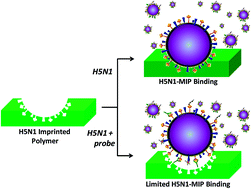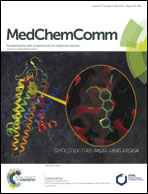A novel approach to identify molecular binding to the influenza virus H5N1: screening using molecularly imprinted polymers (MIPs)†
Abstract
In this report we investigate whether a molecularly imprinted polymer (MIP) of an inactivated strain of influenza A H5N1 could be used to help identify molecules capable of binding to, and inhibiting the function of the virus, via either competitive or allosteric mechanisms. Molecules which bind to the virus and induce a conformational change are expected to show reduced binding to the H5N1 specific MIP. Given the importance of molecular recognition in virus replication, such conformational change might also reduce the effectiveness of neuraminidase (N1) for cleaving the sialic groups necessary for virus replication. We show that the method can indeed differentiate between a potent neuraminidase inhibitor, H1 and H5 antibodies, and N1 specific and non-specific monosaccharide substrates. We suggest that such a method could potentially be used in conjunction with traditional biochemical assays to facilitate the identification of molecules functioning via novel modes of action.


 Please wait while we load your content...
Please wait while we load your content...